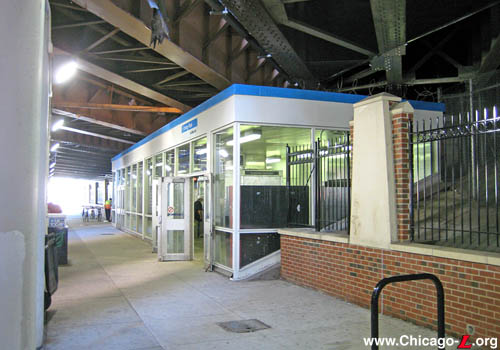
The station house at the
Irving Park Road entrance to Irving Park station is seen
looking east on August 31, 2008. The rectilinear shape of
the building and its steel frame and glass construction
belay its International style design. Irving Park is the
only Kennedy-Dan Ryan station whose fare control area is
below the expressway lanes. For a larger view, click
here.
(Photo by Graham
Garfield)
|
|
Irving
Park
|
|
(4000N/4100W)
Irving Park
|
|
|
|
(4000W/3900N)
Pulaski
|
Irving Park Road and Pulaski Road,
Irving Park
Service
Notes:

|
Blue Line:
O'Hare
|

|
Owl
Service
|
Quick Facts:
|
Address:
|
4131 W. Irving Park Road
(Irving Park
entrance)
|
|
3900 N. Pulaski Road
(Pulaski
auxiliary entrance)
|
Established: February 1, 1970
Original Line: West-Northwest Route, Milwaukee branch
Previous Names: none
|
Skip-Stop Type:
|

|
Station
(1970-1983)
|

|
Station
(1983-1995)
|
Rebuilt: 2016 (platform renovation)
Status: In Use
History:
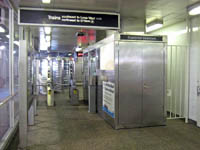
The Skidmore-designed Irving
Park station main entrance interior is seen on August 31,
2008, very much as it was originally built. Note how
everything is harmoniously rectilinear in design, thanks to
Skidmore's holistic approach. For a larger view, click
here.
(Photo by Graham
Garfield)
|
The extension of the Milwaukee
Line of the West-Northwest
Route (the forerunner of today's Blue
Line) reached its new terminal at Jefferson
Park via a new subway and the median of the Kennedy Expressway.
After running in subway under Milwaukee and Kimball avenues, the line
crosses under the eastbound lanes of the John F. Kennedy Expressway
at School Street (3300N), ascends to the surface and continues
northwest another four miles in the median of the Kennedy Expressway
to Jefferson Park (5400N). Built
concurrently with the Dan
Ryan Line -- and together known as the Kennedy-Dan Ryan ("KDR")
project -- the Kennedy
Extension incorporated several new design features that were
considered revolutionary or at least very modern for the time.
The design of the six stations of the Kennedy
Extension was carried out by Skidmore, Owings & Merrill under
the direction of Myron Goldsmith, who developed a modern, functional
form in the late International style popular at the time. Improved
visibility and security, ease of cleaning and more comfortable
working conditions for CTA employees were design goals. Skidmore took
the KDR project in a unique direction, designing all aspects of the
new lines to harmonize in both shapes and materials. All windbreaks,
dividers, and ticket booths were stainless steel. The formal and
functional criteria were expressed in several ways: open,
uncluttered, brightly lit interior spaces; durability, safety,
maximum efficiency of movement; lightness and purity of structure.
The shape of everything, from the buildings to the agents' booths, to
the trashcans, followed together into a seamless design philosophy,
which perfectly captured the boxy, purely functional International
Modern style for which Skidmore is so well known.
Irving Park is one of four median stations on the Kennedy
Extension, which were the centerpieces of Skidmore's design for
the line. The International style stations were constructed of white
steel and glass providing maximum visibility from adjacent streets
and highways boxy. In terms of interior arrangement and design for
the passenger, Skidmore generally followed the edict of modernist
pioneer Mies van der Rohe that "less is more." Except for at a few
locations, there were no concessions provided for passengers. Air
conditioning and a compact washroom with a toilet were provided in
the agents' booths. Restrooms were for employees only, although
payphones were provided for the public. Stainless steel turnstiles,
now an industry standard, were first used in the KDR stations. The
amenities and traffic circulation fit with the architectural design
of the station: efficient but purely functional. Stations were
designed with turnstiles and agents booths arranged for maximum
queuing and circulation effectiveness. The Dan
Ryan and Kennedy
stations were also set up to allow Pay On Train operation, although
without all of the complicated gates and rearrangement built into the
Congress stations.
The boarding platforms are long enough to accommodate 8-car trains.
The supports of the transparent platform canopies, which extend
beyond the center line of the tracks, are white-painted steel frames.
Self-service infrared radiant heaters are located at windbreaks on
the platforms.
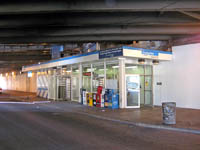
The Pulaski auxiliary
entrance is seen looking southwest on August 31, 2008. The
original station building has been modified with a set of
entry doors where the agent's booth originally was, high
exit rotogates, and new tile cladding. For a larger view,
click here.
(Photo by Graham
Garfield)
|
Irving Park station is different from other Kennedy-Dan
Ryan stations in a few ways. Although it's general design, style,
and arrangement are similar, the site conditions dictated some
deviations. Unlike most KDR locations where the expressway is below
grade and the cross-streets pass on viaducts, resulting in station
houses and fare control areas above the platforms, at Irving Park
Road the expressway passes over the street. This results in the only
KDR station at which the station houses and fare control areas are
below the platforms. (Cermak-Chinatown's
entrances are below the platforms, but the fare control areas at
elevated, at platform level.)
The layout of the station also differs from other KDR stations.
Like Congress Line
stations, the Irving Park station bridges the distance between
streets (Irving Park and Pulaski roads) and has two entrances,
resulting in an unusually long platform to reach those two streets.
The layout for this station dates back to the station's first
conceptual layout seen in the 1958 New
Horizons for Chicago's Metropolitan Area transit plan (see
rendering below). While most
KDR stations were long enough to berth an 8-car train, Irving Park's
platform us nearly 530 feet long, sufficient to berth a 10-car train.
Beyond this, the platform-level continues even farther as a
railing-enclosed walkway to cross to the far sides of Pulaski and
Irving Park roads to auxiliary exits, allowing egress on both sides
of both streets, preventing the need to cross wide, busy streets to
make bus connections. The far sides (north side of Irving Park and
east side of Pulaski) were built to high rotogate exits, while the
near sides of the streets were built to entrances staffed by ticket
agents and equipped with turnstiles. The platform is also somewhat
narrower than other KDR stations, only about 12 feet wide.
In the early 1980s, the CTA was facing financial problems and
sought ways to bring costs under control. One such economizing method
was to reduce the hours of ticket agent coverage at many stations,
especially those with multiple entrances. As a result, the auxiliary
entrance at Pulaski was closed to entering customers on January 24,
1982 except during morning rush hours Monday through Friday. At all
other times, the Pulaski end of the station was exit-only. This
lasted 10 years until the CTA once again found itself in a position
to reduce costs. Effective February 10, 1992, the Pulaski entrance
was closed completely -- one of several stations and station
auxiliary entrances closed at the same time -- becoming exit-only at
all times.
The introduction of CTA's Cubic-manufactured
electronic farecard equipment in the mid-1990s provided the
opportunity to reopen auxiliary entrances without paying the costs of
staffing them. The new fare control equipment included a High-Barrier
Gate (HBG), a tall, cage-like rotating gate that, unlike an exit-only
rotogate which turns in only one direction, has a farecard-reader
attached that will unlock the gate to rotate in the entering
direction with a valid farecard. The CTA reopened the Pulaski
entrance with the installation of an High-Barrier Gate in October
1998, one of several auxiliary entrances reopened with HBGs around
that time. The CTA renovated the entrance by adding doors to enclose
the building and adding new tile wall cladding.
The CTA continued to improve access to the station by installing
additional HBGs. In summer 2004, the auxiliary exit to the north side
of Irving Park Road was improved with the installation of an HBG,
allowing customers to enter on the north side of the street (with a
valid farecard) in addition to the main entrance on the south side of
the street. This provided more convenient bus transfers by
eliminating the need to cross the busy multi-lane Irving Park
Road.
In spring 2008, the CTA replaced the original KDR-style
signage with Green Line
Graphic Standard station name signs and symbol signs. The work
included removal of the 1970-vintage green (indicating its former
status as a "B" station in skip-stop
operation) column and station name signs on the platform, as well as
the installation of new entrance signs over the main (Irving Park)
and auxiliary (Pulaski) entrances.
Your New Blue: Station Improvements

Crews work to demolish the deteriorating platform edge and original platform topping to replace both during the night of August 13, 2016. For a larger view, click here. (CTA photo) |
On December 5, 2013, Mayor Rahm Emanuel and Governor Pat Quinn announced a comprehensive improvement plan for the Blue Line O'Hare Branch (including the northern portion of the Dearborn Subway), an overhaul that will provide faster travel times and updated stations while creating more than 1,300 jobs.
The $492 million plan, called Your New Blue, includes several track and station improvement projects along a 12.5-mile stretch of the Blue Line between the Grand and Cumberland stations, as well as upgrades to the signal system between the Jefferson Park and O'Hare stations. The overall Your New Blue program, beginning construction in 2014 and planned to last four years, is a package of several discrete projects ranging from station improvements to track renewal, signal replacement, traction power upgrades, and subway tunnel water mitigation efforts.
Irving Park is one of 13 stations planned to receive improvements under the program, with Irving Park to receive improvements more modest in scope. Addison, Irving Park, Montrose, Harlem and Cumberland stations were packaged as a group for design and construction, and all five stations had significant deterioration to their island platform decks and particularly the edges cantilevered toward the tracks. To address this, the stations received new platform edge and topping replacement. In addition, walkway railings and platform furniture such as benches, windbreaks and trash cans was rehabilitated or replaced as needed. Light fixtures were provided with new lamps and ballasts, and all five stations were repainted.

Workers set rebar ahead of the concrete pour to form the base structure of a new platform edge for the northbound side of the Irving Park station platform, looking southeast on August 14, 2016. For a larger view, click here. (CTA photo) |
On March 11, 2015, the Chicago Transit Board approved the award of a $25.6 million contract to F.H. Paschen and S.N. Nielsen for the renovation of five O'Hare branch stations, including Addison. Design work began in spring 2015, with rehabilitation work at the Addison, Irving Park, Montrose, Harlem and Cumberland stations to begin in fall 2015. All stations remained open during the construction period, except for a small number of weekend-only closures at Addison and Montrose. In addition, in order to carry out the platform renewal work, each station's platform was closed half at a time, longitudinally down the middle. Trains bypassed the side of the platform being worked on, which was barricaded from passenger access to allow the deck topping to be removed and replaced. Each half-closure and bypass period lasted three weeks (except at Harlem and Cumberland, which were shorter), during which passengers had to "back-ride" (riding to the next stop, exiting and boarding a train back in the opposite direction) or use alternate existing bus or rail services. While inconvenient, the partial station closures allowed the CTA to keep the stations open for customers at all times during platform work.
Irving Park station's platform renewal began with the Forest Park-bound side of the platform, with trains bypassing that side for reconstruction from July 5 to July 26, 2016. This was followed by the O'Hare-bound side of the platform being closed August 9-30. During the first closure, and for some days after, the platform-level walkways to the north auxiliary entrance/exit at the Irving Park Road end of the station, and to the east auxiliary exit at the Pulaski Road end of the station, were also closed for deck reconstruction and replacement of the steel railings -- these walkways and access points were closed from 9pm July 5 to 9pm, August 5.
To complete the replacement of the platform decking and repairs to the railings and curtain walls at each end of the platform, a week-long closure was required at each end because the platform and walkways are so narrow there was no viable way to accomplish the work without blocking access to both the closest stair and the walkway to the farther exit. From 9pm, Thursday, October 13 to 9pm, Thursday, October 20, 2016, the auxiliary entrance/exit on the east and west sides of Pulaski Road was temporarily closed for this work, requiring customers to use the main entrance/exit on the south side of Irving Park Road and the auxiliary entrance/exit on the north side of Irving Park Road. Work then flipped to the other end of the station, where the main entrance/exit on the south side of Irving Park Road and the auxiliary entrance/exit on the north side of Irving Park Road were temporarily closed from 10pm, Thursday, October 20 to 10pm, Thursday, October 27. Customers had to walk from the open entrances to make bus connections normally made at the closed entrances and exits.
Renovation work at Irving Park was substantially completed by late Fall 2016.
Station Artwork
New, one-of-a-kind artwork served as the finishing touch for the Addison and Irving Park Blue Line stations, as part of the renovation and upgrades as part of the Your New Blue program. On December 14, 2016, the Chicago Transit Board awarded contracts to two renowned artists to commission new public art for permanent display at both stations.
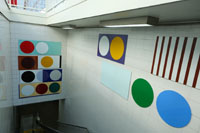
Newly-installed artwork panels at the Irving Park entrance add color and vibrancy to the passageway between the platform and station house, seen in October 2023. For a larger view, click here. (CTA photo) |
CTA selected Chicago-based artist, curator and educator Dan Devening for new artwork at Irving Park station, and internationally acclaimed Italian artist Francesco Simeti for artwork at Addison, selecting the artists from nearly 350 proposals submitted to the agency as part of a Call for Artists issued in February 2016. CTA hosted public meetings with the selected artists in summer 2017 to gather community input, which assisted the artists in their development of site-specific artwork.
The artwork at Irving Park was installed in fall 2023, and formally unveiled in mid-October. The new artwork, titled passin' by; looking up; movin' on, uses vibrant color and a selection of simple shapes to highlight and celebrate the thousands of passengers who travel through the subway, ride the 'L', and eventually arrive at their destination. Full of exuberance and movement, the artwork illustrates the rich diversity of Chicago through a broad lens of simple design, color, and whimsy. Fabricated of porcelain enamel on steel, the multiple modular elements of the artwork bring rhythmic visual energy and drama to the Irving Park station passageways, guiding CTA travelers from the street to the platform and back again.A
The artwork will be paid for with Federal Transit Enhancement funds provided by the Federal Transit Administration (FTA). The artist's contract was valued at $200,000 for the design, engineering, materials & fabrication, delivery, artist fee and insurance. The installation of the artwork was performed by CTA staff including sheet metal workers, and carpenters.B
Escalator and Canopy Replacement
By the mid-2010s, the escalators at Irving Park were reaching end-of-life and beginning to fail. In August 2017, the escalator at the Pulaski entrance broke down and was deemed irreparable. Because the escalators are custom-made, specially designed and built for the unique spaces where they're installed and the heavy use and weather they endure, they are expensive and require time to fabricate, according to CTA; a new, custom-designed escalator at the Irving Park station was estimated to cost around $1 million. As such, CTA had to pursue state capital funding to support replacement of the inoperable escalator, as well as the one at the Irving Park entrance which was likely to fail soon as well.1
In the meantime, construction crews removed the broken escalator at the Pulaski entrance, replacing it with temporary wooden stairs. From July 9 to August 20, 2018, the Pulaski entrance and exits were closed while crews demolished and removed the escalator and built new temporary stairs in their place. During that time, customers could use the Irving Park Road entrances and exits.2
By 2021, CTA had identified funding for a project to replace both escalators, as well as perform additional repairs and improvements at the station. The $12 million project was funded by the State of Illinois Transportation Program. The project would replace the removed escalator at the Pulaski end of the station, as well as the existing escalator at the Irving Park end, which had experienced excessive wear due to water and road salt infiltration and required replacement. In addition to fabricating and installing the new escalators, the project also rebuilt the escalator supports within the station structure. The platform-level canopy roof was also replaced with a new translucent, insulated single panel polycarbonate canopy system, which would help mitigate water infiltration and better protect passengers and the replacement escalators. Finally, new roofs at Irving Park and Pulaski station houses were installed. The contractor for the work was John Burns Construction.3
To perform the work for each escalator, each end of the station was closed for approximately five months. From January 174 to June 15, 2022, the Irving Park Road entrances/exits were closed. While customers used the Pulaski Road auxiliary entrance/exit, a temporary CA booth was constructed and used at the normally-unstaffed Pulaski station house.6 From June 1 to August 14, 2022, the Pulaski Road west auxiliary entrance/exit was closed, and customers used the Irving Park Road entrances/exits or the Pulaski Road east auxiliary exit.7 From June 27 to July 16, 2022, the station's auxiliary exit stairs on the east side of Pulaski Road were also temporarily closed.8
The project was substantially complete in August 2022.9
All Stations Accessibility Program (ASAP)
In July 2018, the CTA released its first plan to make the entire system accessible to people with disabilities over the next 20 years. The All Stations Accessibility Program (ASAP) will cost about $2.1 billion, according to CTA, but the program was not funded at the time of the announcement. Rather, CTA formulated and announced the plan to begin the effort to secure funding by building support and increasing awareness of accessibility needs.10
Given the magnitude of this endeavor, project work was proposed to be performed in four phases over the 20-year period. To help prioritize the non-accessible stations, scores were assessed to each location based on needs and the complexity of work to be performed. The criteria used in determining the needs score is similar to what was used in previous CTA accessibility analyses (i.e. the 2012 Infrastructure Accessibility Task Force [IATF] Plan) such as ridership and gaps between accessible stations. In general, stations with higher needs and lower complexity scores were prioritized for near-term plans. Highly complex stations that require more time for planning, design, construction, agency coordination and community input are part of long-term project plans.11
With the passage of the federal Bipartisan Infrastructure Law signed by President Joe Biden in 2021, a new $1.75 billion discretionary grant program was created and announced. This was the first federal funding program specifically for legacy transit agencies, like CTA, to help increase the number of accessible rail stations. The federal program was championed by U.S. Sen. Tammy Duckworth, a Democrat from Illinois, who modeled it after CTA's ASAP and borrowed the CTA's plan name for the federal program. Duckworth, a veteran who lost her legs in a combat helicopter crash in Iraq, said that lack of progress toward transit station accessibility since the signing of the Americans with Disabilities Act in 1990 had been abysmal -- the ADA largely allowed older buildings without accommodations to be grandfathered in if they predated the law. In 2018, Duckworth applauded the CTA for creating a formal plan for getting the rest of the "L" system accessible, but balked at the slow 20-year timeline; CTA President Carter said his hands were tied unless more funding streams opened. So, the then-freshman senator introduced a bill to implement the ASAP initiative on a federal scale. That legislation was folded into the accessibility program in the federal infrastructure bill. "I actually wanted $10 billion over 10 years," she said in an interview. But, "it's a good start."12
In December 2022, the CTA received $118.5 million from the Federal Transit Administration's (FTA) All Stations Accessibility Program grant program. This grant from FTA will be applied toward helping make the Irving Park, Belmont and Pulaski Blue Line stations accessible to those who use mobility devices. The total estimated cost for the three station projects is approximately $148 million, 80 percent of which will be supported with funds received today through federal ASAP grant program. The remaining funds, approximately $29 million, will be a mix of state and/or local funds.13
The ASAP plan notes that the Irving Park Blue Line station presents a number of challenges and considerations for making the station accessible. Chief among these is the rather narrow width of the platform (12'-2" wide in the center area), which is too narrow to accommodate an elevator with safe passing room around it on either side. This basically makes it impossible to place elevators so they connect to the existing main station house on the south side of Irving Park Road or auxiliary station house on the west side of Pulaski Road without widening the platform, as this would cut off access to the auxiliary entrance/exit on the north side of Irving Park Road, and the auxiliary exit on east side of Pulaski Road and thereby eliminate direct access to westbound buses on Irving Park and northbound buses on Pulaski. Given the width and traffic levels of both streets, forcing passengers to cross these roadways at street-level would be an undesirable safety risk. Widening the platform is not practical due to the presence of the Kennedy Expressway lanes on either side of the tracks, and relocating them is prohibitively expensive and not practical. It is also noted that the size of the existing station houses are too small functionally accommodate elevators.14
Given these constraints, the ASAP plan proposes to add new staffed station houses on the north side of Irving Park Road and on the east side of Pulaski Road, each of which would include an elevator and stairs. This would place the elevators at the far ends of the platform, negating the platform width issue in terms of room to navigate around them. The new Irving Park and Pulaski station houses would require an easement from IDOT, as they would be located under the expressway and against the bridge abutments. In addition, proposed Pulaski station house would also require a permit/agreement from the City of Chicago because it would be located in what is currently a dedicated driveway/bus lane under the expressway bridge (on the east side of Pulaski, there is no room under the expressway abutment to 'tuck' the new station house out of the street right-of-way), requiring the roadway lanes to be vacated. Given these needs, the proposed changes will require extensive interagency coordination between the CTA, CDOT, and IDOT.15
The plan calls for the existing stationhouse on the south side of Irving Park Road to be converted to an unstaffed auxiliary entrance, while the current unstaffed auxiliary entrance on the west side of Pulaski Road would remain unchanged . The existing stairways and escalators between these existing entrances and the platform would also remain.16
Details regarding the scope and timeline of project work for the Pulaski station will be determined following the awarding of contracts, which, at the time of the funding announcement in December 2022, was expected in late 2023/early 2024.17
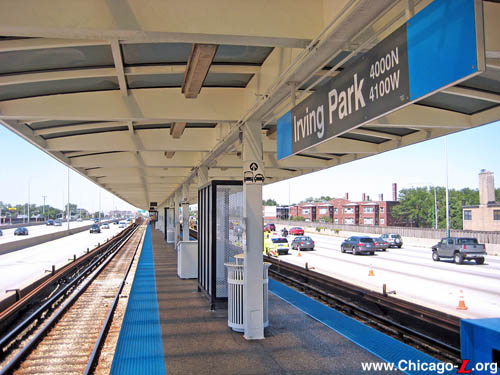
The Irving Park platform,
looking northwest on August 31, 2008, sports its
newly-installed station name and column signs. The original
stainless steel windbreaks were also replaced with new
shelters using modular parts formerly used for bus stop
shelters during spring 2008. The station still has its
original aggregate flooring and plexiglas skylight "bubbles"
in the Skidmore-designed steel canopy. For a larger view,
click here.
(Photo by Graham
Garfield)
|

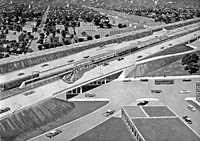
|
NorthwestExp@Pulaski.jpg
(182k)
Artist's rendering from the 1958 New
Horizons for Chicago's Metropolitan Area of the
proposed Northwest Expressway extension where it would pass
Pulaski Road. The Irving Park-Pulaski station facility that
was built is very similar in appearance to this rendering.
including the multiple entrances. (Graham
Garfield Collection)
|

|
irvingpark.irvingpark03.jpg
(153k)
The auxiliary entrance on the north side of Irving Park Road
is seen looking west from the bus stop on August 31, 2008.
The stairs were part of the original station construction,
but the signage was added in 2004 to promote the new
entrance capabilities. (Photo by Graham
Garfield)
|

|
irvingpark.irvingpark04.jpg
(168k)
This High-Barrier Gate was added at the northwest end of the
walkway from the platform to the north side of Irving Park
Road. This location was originally outfitted with an
exit-only rotogate to allow egress to connecting buses but
prevented entry. This HBG, seen looking southeast from the
unpaid side on August 31, 2008, was installed in summer 2004
to allow entrance and improve accessibility to the station.
(Photo by Graham Garfield)
|
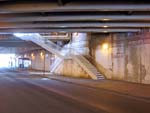
|
irvingpark.pulaksi02.jpg (137k)
The east side of Pulaski Road sports an auxiliary exit,
allowing customers to transfer to northbound Pulaski buses
without crossing wide Pulaski Road. The Irving Park station
has our egress points, on both sides of the two streets it
serves. This view looks north on August 31, 2008. Note the JCDecaux bus shelter for northbound buses, although the whole area is
under a solid expressway bridge. (Photo by
Graham Garfield) |
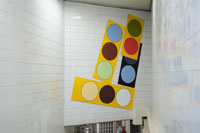
|
irvingpark_20231000b_irvingpark.jpg (178k)
A newly-installed artwork panel at the Irving Park entrance adds color and vibrancy to the passageway between the platform and station house, seen in October 2023. (CTA photo) |

|

|
Notes:
A. "CTA Expands its Public Art Collection with a New Installation at the Irving Park Blue Line Station." CTA press release, October 12, 2023.
B. Ibid.
1. Hernandez, Alex. "Pulaski Entrance At Irving Park Blue Line Stop Will Soon Close To Remove Broken 48-Year-Old Escalator." Block Club Chicago, July 13, 2018.
2. Chicago Transit Authority. "Weekday Service Changes: Jul 9 - 13." Email subscription from CTA, received 6:04pm, Fri, July 6, 2018.
3.
Chicago Transit Authority. "Construction Project Briefing - September 14, 2022." CTA web site, retrieved February 14, 2023.
4. Chicago Transit Authority. "Weekday Service Changes: Jan 17 - 21." Email subscription from CTA, received 11:06am, Mon, Jan 17, 2022.
5. Chicago Transit Authority. "Weekday Service Changes: May 30 - Jun 3." Email subscription from CTA, received 9:46pm, Sat, May 28, 2022.
6.
Chicago Transit Authority. "Construction Project Briefing - September 14, 2022," ibid.
7. Chicago Transit Authority. "Weekday Service Changes: May 30 - Jun 3," ibid.
8.
Chicago Transit Authority. "Weekday Service Changes: Jun 27 - Jul 1." Email subscription from CTA, received 7:42am, Mon, Jun 27, 2022.
9.
Chicago Transit Authority. "Construction Project Briefing - September 14, 2022," ibid.
10.
Wisniewski, Mary. "CTA plans for accessible stations, though funds are not available." Chicago Tribune, July 19, 2018.
11. Chicago Transit Authority. "All Stations Accessibility Program (ASAP)" flyer. July 2018.
12. Hinz, Greg. "The CTA just got $118 million for Blue Line elevators. Here's the backstory." Crain's Chicago Business, December 22, 2022.
13.
"CTA Receives $118.5 Million in Federal 'All Stations Accessibility Program' Grant Funds." CTA press release, December 20, 2022.
14. Chicago Transit Authority. All Stations Accessibility Program (ASAP) Strategic Plan, July 2018, pp. 51-52.
15. Ibid, p. 51.
16. Ibid.
17. CTA press release, 2022.














